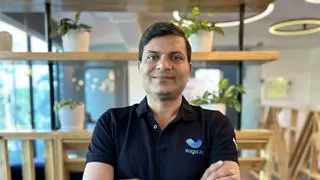Anil Srinivasan’s is a familiar face, especially among music aficionados in Chennai. A classical pianist, Anil cannot recollect how he took to playing the piano, but has been playing on it ever since he can remember. He recollects being told that he played on a piano as a two-year-old while visiting his father’s friend’s house with his parents. He has cut albums with both Western and Indian classical musicians. That Anil is also academically well accomplished is not something that is talked about too much.
“I am an academic oriented person. I always liked research. I am mathematical by nature, I love problem solving, very analytical and I like analytical modelling,” he says.
It was while doing his M.Phil at Columbia that he rediscovered his passion for music. “Part of what I did in my research at Columbia was looking at cognitive neuroscience and the effect music has on the brain. I was getting deeper into synaesthesia and looking at how networks get orientated differently in exposure to certain types of music,” he says.
Music is so integral to the development of human intelligence, but was under-represented in schools. Anil says he was always fascinated by school education, which needed interventions that were systemic. On his return to India, he visited CBSE schools and those run by the Tamil Nadu Government and the Chennai Corporation just to get a feel of what the music period was about. He was so appalled at the way music was taught in schools. Carnatic music, in his opinion, does not lend itself to mass teaching and is more one-on-one. Schools still persisted in teaching the same old songs to classes of 30-40 students. Students may be interested in learning music, but that doesn’t mean they have to perform. A child may be interested in playing cricket for fun, but may not aspire to become a top cricketer. Why should it be any different for music, he wondered.

Schools, he says, were initially sceptical that music can contribute to a child’s improvement and intelligence, although it has been medically researched and proven. “What I did find is that all school heads felt that music is important, but they also felt that they don’t have the fix. They really don’t know what else to do other than getting this one music teacher,” says Anil. Music teachers in schools were confined to what they knew. “The songs you and I learnt in school are still being taught. Nothing much has changed. How is this going to pass muster in the 21st century. Why should every child be forced to do this. It is drudgery,” says Anil.
Learning through music
That is when Anil came up with the idea of making learning through music and drew up 460 lesson plans, age graded, multi-stage, multi-class, multi-disciplinary and multi-genre. How interesting would it be for a child to learn about Doppler effect – which deals with the increase or decrease in the frequency of sound or light waves as the source of the sound and the observer move towards or away from each other – through a song sung by the students themselves rather than being taught from a textbook.
How do you do that? Anil says one group of children are made to stand on one side of a wall and another group of children is singing a song and moves towards the other group. As the group that is singing moves closer to the other group, the song appears louder and it appears softer when the group moves away.
And, the teacher is drawing sound waves on the ground and teaching the connection between the sound waves, frequency, volume.
The Doppler effect registers itself on the brain of a child as an experiential idea that he or she did along with friends as opposed to reading it from a textbook, says Anil.
Almost 70 per cent of the songs that are used to teach the subjects have been created by Anil. He even hums lines from one such song to explain a mathematical equation. He says he set up Rhapsody to make a dent on the education system. There was no point being outside and complaining about the system. “I wanted to look at learning. Let us not focus on curriculum, let us focus on learning. Let us not worry about innovation indices, let us worry about the process,” he says. Music, he adds, cannot be taught in an outcome-oriented fashion.
“I cannot teach it so that you go win a competition. You must love learning. It has to build imagination. You need creativity.” The schools assess the progress of their children every month.
While Rhapsody charges the private schools for the classes, it has been able to get companies such as Ashok Leyland to fund these classes in government and Chennai Corporation schools.
Pan-India plan
According to Anil, the plan is to take Rhapsody all India. For which it will need to train more teachers and bring in more schools in the network. The venture is growing its team, including hiring marketing professionals. There is enormous demand from a few of the North-East States and from Jammu & Kashmir. There is demand for the lessons globally too, from Singapore, for instance, while the State Attorney of New York has spoken to him about the lessons.
He plans to have an online avatar of Rhapsody in 2021-22, while the overseas foray will happen only after the Series A fund raise, which is sometime in 2022-23.
“Scaling within India has to be accomplished between now and 2022,” says Anil.
The company had a topline of ₹1.5 crore last year and hopes to end this year with a topline of ₹4 crore. It broke even in 2017-18 and 2018-19 was a profitable year.








Comments
Comments have to be in English, and in full sentences. They cannot be abusive or personal. Please abide by our community guidelines for posting your comments.
We have migrated to a new commenting platform. If you are already a registered user of TheHindu Businessline and logged in, you may continue to engage with our articles. If you do not have an account please register and login to post comments. Users can access their older comments by logging into their accounts on Vuukle.